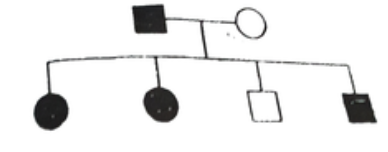Why is pedigree analysis done in study of human genetics ? State the conclusions that can be drawn from it.
Step-by-Step Solution:
1. Definition of Pedigree Analysis:
- Pedigree analysis is a method used to study the inheritance patterns of specific traits or genetic disorders within a family over several generations. It involves creating a family tree that illustrates how traits are passed down from parents to offspring.
2. Purpose of Pedigree Analysis:
- The primary purpose of pedigree analysis in human genetics is to understand the inheritance patterns of traits or disorders, especially since controlled breeding experiments (like those done in plants and animals) cannot be performed on humans.
3. Symbols and Conventions:
- In pedigree charts, specific symbols are used:
- Squares represent males.
- Circles represent females.
- A horizontal line connecting a square and a circle indicates marriage.
- Offspring are represented by lines descending from the marriage line.
- A shaded shape indicates an affected individual, while an unshaded shape indicates an unaffected individual.
4. Analyzing Inheritance Patterns:
- By examining the pedigree chart, one can determine whether a trait is dominant or recessive. For example, if unaffected parents have affected offspring, the trait is likely recessive, indicating that the parents are carriers of the recessive allele.
5. Determining Autosomal vs. Sex-Linked Traits:
- Pedigree analysis can also help identify whether a disorder is autosomal (located on non-sex chromosomes) or sex-linked (located on sex chromosomes). For instance, if a trait appears more frequently in males than females, it may suggest a sex-linked inheritance pattern.
6. Conclusions from Pedigree Analysis:
- From the analysis, conclusions can be drawn about:
- The nature of the trait (dominant or recessive).
- Whether the trait is autosomal or sex-linked.
- The likelihood of the trait being passed on to future generations.
Conclusions:
- Pedigree analysis is crucial in human genetics for understanding inheritance patterns.
- It allows researchers to determine if traits are dominant or recessive and whether they are autosomal or sex-linked.
- Pedigree analysis is a method used to study the inheritance patterns of specific traits or genetic disorders within a family over several generations. It involves creating a family tree that illustrates how traits are passed down from parents to offspring.
- The primary purpose of pedigree analysis in human genetics is to understand the inheritance patterns of traits or disorders, especially since controlled breeding experiments (like those done in plants and animals) cannot be performed on humans.
- In pedigree charts, specific symbols are used:
- Squares represent males.
- Circles represent females.
- A horizontal line connecting a square and a circle indicates marriage.
- Offspring are represented by lines descending from the marriage line.
- A shaded shape indicates an affected individual, while an unshaded shape indicates an unaffected individual.
- By examining the pedigree chart, one can determine whether a trait is dominant or recessive. For example, if unaffected parents have affected offspring, the trait is likely recessive, indicating that the parents are carriers of the recessive allele.
- Pedigree analysis can also help identify whether a disorder is autosomal (located on non-sex chromosomes) or sex-linked (located on sex chromosomes). For instance, if a trait appears more frequently in males than females, it may suggest a sex-linked inheritance pattern.
- From the analysis, conclusions can be drawn about:
- The nature of the trait (dominant or recessive).
- Whether the trait is autosomal or sex-linked.
- The likelihood of the trait being passed on to future generations.
- Pedigree analysis is crucial in human genetics for understanding inheritance patterns.
- It allows researchers to determine if traits are dominant or recessive and whether they are autosomal or sex-linked.
Topper's Solved these Questions
- XII BOARDSBOOK - XII BOARD PREVIOUS YEAR PAPER ENGLISHCHAPTER - XII BOARDSEXERCISE - SET - I SECTION D
8 Videos
- XII BOARDSBOOK - XII BOARD PREVIOUS YEAR PAPER ENGLISHCHAPTER - XII BOARDSEXERCISE - DELHI BOARD 2016
1 Video
- XII BOARDSBOOK - XII BOARD PREVIOUS YEAR PAPER ENGLISHCHAPTER - XII BOARDSEXERCISE - C.B.S.E. CLASS- XII
99 Videos
- SAMPLE PAPER 2019BOOK - XII BOARD PREVIOUS YEAR PAPER ENGLISHCHAPTER - SAMPLE PAPER 2019EXERCISE - Section E Part B
3 Videos
Similar Questions
Knowledge Check
Study the given pedigree chart of a certain family and select the correct conclusion which can be drawn for the character
 AThe female parent is heterozygousBThe parents could not have had a normal daughter for this characterCThe trait under study could not be colourblindnessDThe male parent is homozygous dominant
AThe female parent is heterozygousBThe parents could not have had a normal daughter for this characterCThe trait under study could not be colourblindnessDThe male parent is homozygous dominantA conclusion drawn from the passage is that:
Afear of failure removes complacency in a person.Bfear of failure is necessary for one to value success.Cfailure is the growth factor as one learns from it and grows.Dthe loss of faith and hope is believed to arise from failure
State the condition for maximum current to be drawn from the cell.
View SolutionWhat is pedigree analysis? Suggest how such an analysis, can be useful.
View SolutionStudy the pedigree chart of a certain family given below and select the correct conclusion which can be drawn for the character

View SolutionSee the given figure below and answer the given questions?
What are the conclusions drawn from the experiment ?
View SolutionThe circle to which two tangents can be drawn from origin is
View SolutionWhat is Pedigree analysis? Suggest how much analysis can be useful?
View Solution
